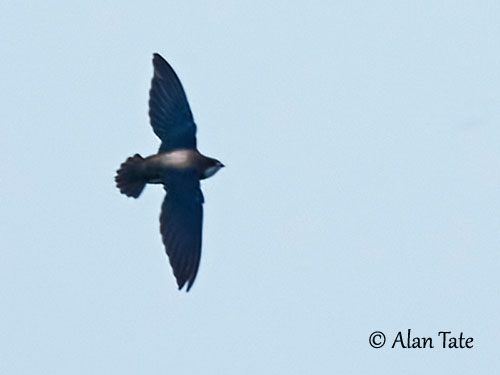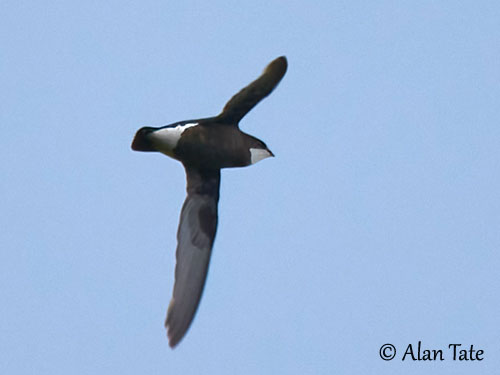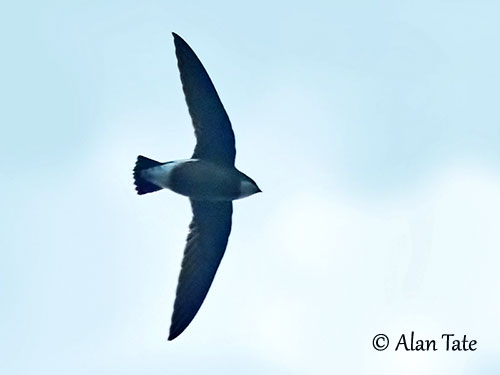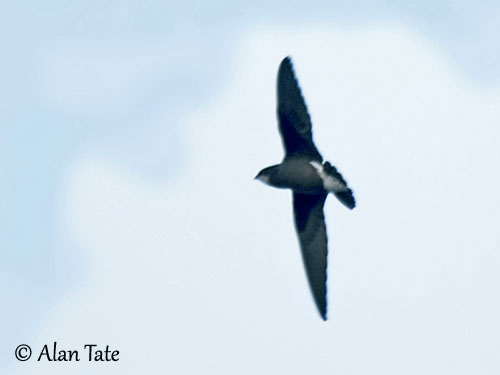
REPRODUCTION OF THIS SPECIES:
The laying of the nominate race occurs from late May to early June in Siberia and Japan, but it may vary depending on the range.
The White-throated Needletail nests in tree hollows or wood crevices. The nest is a shallow depression or a scrape formed in the debris, at the bottom of a hollow in tall conifer. The species is also reported nesting in cliffs in Japan.
The female lays 2-7 white eggs, and the incubation starts with the first egg laid. Both adults share this period during 40 days.
The chicks are blind are naked on hatching. They are fed by regurgitation of insect food directly into the throat. The nest is kept clean by the combined efforts of both parents and chicks. The young fledge 40-42 days after hatching.
PROTECTION / THREATS / STATUS:
The White-throated Needletail has large range in which it is reported to be local and uncommon. The species is affected by permanent clearing of forests and woodlands, and the use of pesticides reduces abundance of invertebrates, especially termite alates. Illegal logging of Siberian forests is also an important problem, as it removes mainly old and mature trees suitable for breeding because they provide hollows and cavities used as nest-sites.
The size of the population is unknown, but it is suspected to be declining locally, due to habitat destruction.
However, the species is not considered globally threated, and the White-throated Needletail is currently evaluated as Least Concern.
Fr: Martinet épineux
Ang: White-throated Needletail
All: Stachelschwanzsegler
Esp: Vencejo Mongol
Ita: Rondone codacuta
Nd: Stekelstaartgierzwaluw
Sd: taggstjärtseglare
Photographers:
Alan & Ann Tate
AA Bird Photography
Text by Nicole Bouglouan
Sources:
HANDBOOK OF THE BIRDS OF THE WORLD Vol 5 by Josep del Hoyo-Andrew Elliott-Jordi Sargatal - Lynx Edicions - ISBN: 8487334253
Swifts: A Guide to the Swifts and Treeswifts of the World, Second Edition Hardcover – January 1, 1995 – By Phil Chantler – Pica Press – ISBN: 0300079362 – 978-0300079364 – 237 pages
A Field Guide to the Birds of South-East Asia by Craig Robson. New Holland Publishers. ISBN: 9781780090498
Birds in backyards (Birds Australia and Australian Museum)
What Bird-The ultimate Bird Guide (Mitchell Waite)
Wikipedia, the free encyclopaedia
White-throated Needletail
Hirundapus caudacutus
Apodiformes Order – Apodidae Family
INTRODUCTION:
The White-throated Needletail is a large swift with long, curved wings and short, square tail with protruding feather shafts involving a spiky appearance giving the species its name.
It breeds in Central Asia and Southern Siberia, and migrates southwards to spend the winter in Southern Asia and Eastern Australia. Two subspecies share this wide range.
It usually frequents timbered ridges, rocky hilltops and rock crevices. It feeds on a variety of flying insects caught in flight. It builds its nest in a hollow or crevice high above the ground, in a tall tree, often a conifer. Both adults share the nesting duties.
The White-throated Needletail is described as “local and uncommon” throughout the range, although it may become commoner in some areas. These birds are threatened by destruction of Siberian forests and locally in Japan.
But currently, the species is not globally threatened.
DESCRIPTION OF THE BIRD:
Biometrics:
Length: 19-21 cm
Weight: M: 48-169 g – F: 65-125 g
The White-throated Needletail has cigar-shaped body with short, square tail and long, broad, curved wings.
The plumage is dark with contrasting white areas on mantle, throat, forehead, lores, and a white horseshoe-like mark on flanks, extending on the undertail-coverts.
On the upperparts, the back is pale brown, but paler on centre of lower mantle and back, becoming darker towards the nape. The central rump is darker on sides and uppertail-coverts. The short tail is black with green gloss, and with weak, short rectrix spines protruding up to 6 mm beyond the central rectrices, but only 2,5 mm beyond the outermost feathers.
On the upperwing, the flight-feathers are black with paler brown inner webs of primaries. The wing-coverts are black. Primary coverts and flight-feathers show blue gloss. Tertials have white inner webs. Scapulars are olive-brown.

On the underwing, the flight-feathers are paler and the colour is fairly uniform with the coverts, but median and lesser coverts are blackish-brown, like the axillaries.
The underparts, including breats and upper flanks to vent, are dark olive-brown with brown gloss in fresh plumage. Lower flanks and undertail-coverts are white.
We can see a contrasting white throat patch, extending from the gape, below the ear-coverts and onto the lower throat. Lores and forehead are white, although some individuals may show browner centre of forehead. Rest of head and nape are dark olive-brown with greenish-blue gloss in fresh plumage.
The short bill is black. The eyes are blackish-brown. Short legs and strong feet are black.
Male and female are similar.
The juvenile is less glossy overall and mainly on the upperwing and tail. The throat is darker and less contrasting, the mantle patch is less conspicuous, the lower flanks are spotted and streaked black and the undertail-coverts are tipped black. On the head, forehead and lores are dark to grey-brown.
The 1st year retains the grey-brown forehead and is duller than adults.
SUBSPECIES AND RANGE:
The White-throated Needletail has two subspecies that differ in colour of lores and upperparts.
H.c. caudacutus (described above and displayed) breeds from C Siberia E to Sakhalin and the Kuril Islands, and S to N and E Mongolia, NE China, Korea and Japan.
It winters in S New Guinea and E Australia, occasionally in New Zealand.

H.c. nudipes breeds irregularly in the Himalayan foothills from N Pakistan E to Assam, Arunachal Pradesh through N Myanmar to S China.
The wintering areas are poorly known, but they may include the Malay Peninsula and Java.
This race differs from nominate by uniformly black lores and forehead. The mantle patch is less distinct and the underparts are generally darker with green gloss. The upperparts are glossed darker blue.
HABITAT:
The White-throated Needletail can be found between 1,500 and 4,000 metres of elevation in the Himalayas where it forages over upland grasslands and river valleys.
This species usually forages above forested areas in most parts of the range, including above hills with open areas in Siberia. It can be seen flying over a variety of habitats according to weather conditions.
In Australia during winter, it occurs in both mountainous and coastal regions. In Papua New Guinea, it is found above the lowland rainforest zone.
CALLS AND SONGS: SOUNDS BY XENO-CANTO
The White-throated Needletail utters a rapid, insect-like chattering “trp-trp-trp-trp-trp-trp…” which duration and speed may vary, but this sound is loud and well audible at a distance.
Other sounds are also heard, such as a loud, sharp call, a chirp, a piping sound and a churring twitter.
BEHAVIOUR IN THE WILD:
The White-throated Needletail feeds on a variety of flying insects such as termites, ants, beetles and flies. The prey are caught in flight with the wide gaping bill. While the bird is feeding, the eyes are protected with a membrane and a small ridge of feathers. It also drinks in flight by skimming the water surface while flying low above the water.

The White-throated Needletail forages at various heights, from 1 metre while skimming the ground to catch insects on the mud, to at least 1,800 metres high. It often forages on the edge of low pressure systems, but they are also observed foraging in rising thermal currents associated with storm fronts and bushfires, or by moving with wind fronts.
The species is gregarious and may form large single-species feeding flocks.
The White-throated Needletail performs aerial courtship displays consisting of series of vertical flights. Even the copulation is believed to take place in flight.
The nest is an unlined scrape in debris at the bottom of hollow or crevice high above the ground in tall conifer. They are apparently monogamous.
The needletails do not use saliva in nest-building. This fact is unusual within the family Apodidae.
The White-throated Needletail of nominate race is a long-distance migrant. There are some records in W Europe in April/July (7 from Britain). In North America, it has been recorded from the Pribilof Islands. In Southern hemisphere, it has been recorded from Seychelles, Fiji, New Zealand and Macquarie Island.
The race “nudipes” is probably resident or just summer visitor in Bhutan. It is reported to appear or disappear suddenly at localities, involving complicated migratory status.
The White-throated Needletail is a fast-flying species. It spends most of its time on the wing, landing only for breeding and roosting. The very short legs and the long wings do not allow the bird to take off from the ground. However, the short legs and the strong feet are used for clinging to vertical surfaces.
The flight is very fast with several rapid wingbeats followed by swooping glides.
From observations, this species is able to fly at speeds of up to 130 km/hour, usually between 111 and 170 km/hour.
